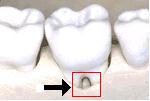Bone Loss: in the context of periodontal disease, bone loss refers to destruction of the support around teeth caused by plaque-induced inflammation. Bone loss, if untreated, is typically progressive and can eventually result in the loss of teeth.
Calculus: also known as “tartar” is a hardened form of plaque that must be removed by your dentist or dental hygienist. It cannot be removed with a toothbrush or dental floss.
Comprehensive Dentistry: is an approach to dental diagnosis and treatment that addresses at the entire mouth as a system rather than individual teeth. Thorough examination, diagnosis, and interdisciplinary treatment planning, which involves your general dentist and possibly other dental specialists, are central to this approach to treatment.
Crown Elongation: a surgical procedure that is performed to increase the amount of available tooth structure and allow for proper restoration of the tooth.
Frenulectomy: a surgical procedure designed to remove the frenulum or tissue between the teeth.
Frenulum: the strip of tissue between the teeth. This strip of tissue can cause gum problems, complicate oral hygiene, and cause increased spacing between the teeth.
Furcation: the back teeth have more than one root. The furcation is the point where the tooth diverges into separate roots. This area can be especially difficult to keep clean and healthy if bone loss exposes this area to the oral cavity.

Gingiva: commonly known as “gums” is the coral pink tissue that is in direct contact with the tooth. This tissue is attached to the tooth as well as the bone and acts like the caulking around your bathtub, protecting the tooth support from bacteria in your mouth.
Gingival Recession (Gum Recession): a condition where the gum tissue appears to be shrinking away from the tooth. Gingival recession may be a symptom of gum disease or due to overly aggressive tooth brushing. This condition, if left untreated, may predispose to future tooth loss.
Gingivitis: an inflammatory condition of the gingiva (gums) most commonly caused by plaque bacteria and the body’s immune response to the plaque.
Gingivoplasty: the surgical reshaping of the gum line performed in order to improve esthetics and oral hygiene of the patient.
Periodontal Disease or Periodontitis: an inflammatory condition of the support around the teeth caused by plaque bacteria and the body’s immune response to the plaque. This condition may progress without symptoms and is the leading cause of tooth loss in adults.
Periodontal Regeneration: describes several periodontal procedures designed to restore lost and damaged support of the tooth.
Periodontal Surgery: any number of procedures designed to correct periodontal disease.
Periodontist: A dental specialist who focuses on the health of the supporting structures around the teeth.
Plaque: the accumulation and growth of bacteria around the teeth and gums. Plaque begins to re-form as soon as you finish brushing and flossing your teeth. Plaque is the primary cause of most forms of gum disease.
Pocket or Pocketing: a disparity between the gumline and underlying bone support around the teeth. A pocket is most commonly the result of destruction of the bone support around the teeth and is caused by plaque bacteria-induced inflammation around the teeth. Pockets become areas not accessible to your toothbrush and dental floss and allow the plaque bacteria to further compromise the support of your teeth. Periodontal pockets are commonly measured by using a periodontal probe.
Scaling/ Root Planing: a non-surgical procedure where plaque, calculus/tartar, and inflammatory tissue is removed from under the gum line.
Uneven or High Gingival Margin: many conditions may cause a high or uneven gumline. This can be unattractive and can make it hard to keep your mouth clean.

